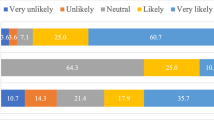Abstract
Xiaflex® (collagenase clostridium histolyticum) is a Food and Drug Administration-approved treatment for patients with Peyronie’s disease. Despite its approval and implementation, there is concern that urologists in training are offered minimal exposure to its use. Thus, the purpose of this study was to evaluate the exposure of urology residents to Peyronie’s disease and its management, particularly Xiaflex®. A Google Forms survey regarding the exposure of residents to Peyronie’s disease and use of Xiaflex® was created and disseminated through email to urology programs. Overall, 47 institutional responses were received. At 45 institutions (95.7%), residents receive training in directly evaluating and caring for patients with Peyronie’s disease. At 46 institutions (97.9%), residents receive training in observing and/or performing surgical procedures for Peyronie’s disease. Residents at 31 institutions (66.0%) receive observational or procedural training for non-surgical management of Peyronie’s disease, specifically Xiaflex®. Residents receive non-surgical training from an academic faculty who is fellowship trained in sexual medicine at 25 institutions and an academic faculty not trained in sexual medicine at six institutions. There exists a glaring disparity in residency exposure to Xiaflex®. Further research is warranted to elucidate how programs can provide residents with further exposure to the use of Xiaflex® in patients with Peyronie’s disease.
This is a preview of subscription content, access via your institution
Access options
Subscribe to this journal
Receive 8 print issues and online access
$259.00 per year
only $32.38 per issue
Buy this article
- Purchase on Springer Link
- Instant access to full article PDF
Prices may be subject to local taxes which are calculated during checkout





Similar content being viewed by others

Data availability
All data generated or analyzed during this study are included in this published article.
References
Paulis G, Romano G, Paulis A. Prevalence, psychological impact, and risk factors of erectile dysfunction in patients with Peyronie’s disease: a retrospective analysis of 309 cases. Res Rep. Urol. 2016;8:95–103.
Smith JF, Walsh TJ, Conti SL, Turek P, Lue T. Risk factors for emotional and relationship problems in Peyronie’s disease. J Sex Med. 2008;5:2179–84. https://doi.org/10.1111/j.1743-6109.2008.00949.x.
Stuntz M, Perlaky A, des Vignes F, Kyriakides T, Glass D. The prevalence of Peyronie’s disease in the United States: a population-based study. PLoS One. 2016;11:e0150157. https://doi.org/10.1371/journal.pone.0150157.
Chung E, Gillman M, Rushton D, Love C, Katz D. Prevalence of penile curvature: a population-based cross-sectional study in metropolitan and rural cities in Australia. BJU Int. 2018;122:42–49. https://doi.org/10.1111/bju.14605.
Nguyen HM, Hellstrom WJ, Alzweri L, Chung A, Virasoro R, Tapscott A, et al. 108 Intralesional collagenase clostridium histolyticum causes meaningful improvement in men with peyronie’s Disease: the results of a multi-institutional analysis. J Sex Med. 2019;16:S55–6.
Gelbard M, Goldstein I, Hellstrom WJ, McMahon CG, Smith T, Tursi J, et al. Clinical efficacy, safety and tolerability of collagenase clostridium histolyticum for the treatment of peyronie disease in 2 large double-blind, randomized, placebo controlled phase 3 studies. J Urol. 2013;190:199–207.
Gelbard MK, Lindner A, Kaufman JJ. The use of collagenase in the treatment of Peyronie’s disease. J Urol. 1985;134:280–3.
Nehra A, Alterowitz R, Culkin DJ, Faraday M, Hakim L, Heidelbaugh J, et al. Peyronie’s disease: AUA guideline. J Urol. 2015;194:745–53. https://doi.org/10.1016/j.juro.2015.05.098.
Trost L, Huang H, Han X, Burudpakdee C, Hu Y. Treatment patterns and healthcare outcomes with collagenase clostridium histolyticum vs surgery in Peyronie’s disease: a retrospective claims database analysis. Sex Med. 2021;9:100321. https://doi.org/10.1016/j.esxm.2021.100321.
Moghalu OI, Das R, Horns J, Campbell A, Hotaling JM, Pastuszak AW. Trends in treatment of Peyronie’s disease in adult men in the United States from 2008 to 2017—results from an encounter and claims database. Int J Impot Res. 2022;34:280–8. https://doi.org/10.1038/s41443-021-00430-x.
Oberlin DT, Liu JS, Hofer MD, Milose J, Matulewicz RS, Flury SC, et al. An analysis of case logs from American urologists in the treatment of Peyronie’s disease. Urology. 2016;87:205–9. https://doi.org/10.1016/j.urology.2015.08.033.
Masterson TA, Nackeeran S, Rainer Q, Hauser N, Marcovich R, Ramasamy R. Survey of microsurgery training availability in US urology residency programs. World J Mens Health. 2021;39:376–80. https://doi.org/10.5534/wjmh.190162.
Author information
Authors and Affiliations
Contributions
JL, KS, RVR, FR, AB, PR, NK, TM, and RR prepared the manuscript and figures. All authors approved the submitted manuscript.
Corresponding author
Ethics declarations
Competing interests
The authors declare no competing interests.
Additional information
Publisher’s note Springer Nature remains neutral with regard to jurisdictional claims in published maps and institutional affiliations.
Rights and permissions
Springer Nature or its licensor (e.g. a society or other partner) holds exclusive rights to this article under a publishing agreement with the author(s) or other rightsholder(s); author self-archiving of the accepted manuscript version of this article is solely governed by the terms of such publishing agreement and applicable law.
About this article
Cite this article
Loloi, J., Schuppe, K., Reddy, R.V. et al. A survey of exposure to the use of Xiaflex for the treatment of Peyronie’s disease among United States urology residency programs. Int J Impot Res 36, 155–159 (2024). https://doi.org/10.1038/s41443-023-00781-7
Received:
Revised:
Accepted:
Published:
Issue Date:
DOI: https://doi.org/10.1038/s41443-023-00781-7
This article is cited by
-
Unveiling treatment horizons and contemporary perspectives in Peyronie’s disease – take home messages from Laurance A. Levine special issue
International Journal of Impotence Research (2024)


